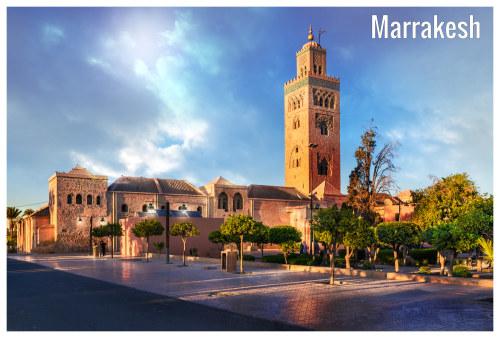
August
Weather in August
Temperature
Marrakesh ushers in August with an average high-temperature of a still torrid 36.5°C (97.7°F), showing a close resemblance to the previous month. Marrakesh documents a marked decrease from day to night, with an average low of 20.1°C (68.2°F) throughout August.Heat index
The heat index for August is appraised at a blisteringly hot 43°C (109.4°F). Heed: Expect heat cramps and heat exhaustion. Continued action may cause heatstroke.Remember that heat index calculations are made for conditions in the shade with light wind. The heat index has the possibility to be enhanced by 15 Fahrenheit (8 Celsius) degrees when there is direct sun exposure.
Note: The heat index, also known as 'feels like' or 'real feel', is a fusion of air temperature and moisture levels to demonstrate the sensation of heat. Elements such as metabolic variations, pregnancy, and physical exertion can influence one's weather perception. Should you be directly under the sun, anticipate a possible increase in the heat index by up to 15 Fahrenheit (8 Celsius) degrees. Heat index values remain especially vital for babies and toddlers. Children often fail to recognize the requirement to rest and rehydrate. Thirst, being a late symptom of dehydration, underlines the importance of maintaining hydration, especially during ongoing physical activities.
When it comes to cooling down, the human body's primary method is through perspiration, making use of sweat evaporation to eliminate excess heat. With high air temperature and humidity (high heat index) conditions, sweat production is restricted, leading to an amplified perception of heat. When heat uptake goes beyond the body's cooling mechanisms, there's a surge in body temperature, posing health risks.
Humidity
The months with the lowest humidity in Marrakesh are July and August, with an average relative humidity of 47%.Rainfall
In Marrakesh, in August, it is raining for 1.2 days, with typically 3mm (0.12") of accumulated precipitation. In Marrakesh, during the entire year, the rain falls for 58.8 days and collects up to 281mm (11.06") of precipitation.Daylight
In August, the average length of the day is 13h and 17min.On the first day of the month, sunrise is at 06:48 and sunset at 20:28. On the last day of August, sunrise is at 07:07 and sunset at 19:56 +01.
Sunshine
The average sunshine in August in Marrakesh is 10.2h.UV index
In August, the average daily maximum UV index is 10. A UV Index of 8 to 10 symbolizes a very high health vulnerability from unsafe exposure to UV radiation for ordinary individuals.Note: In August, the maximum UV index of 10 suggests this advice:
Always be cautious. Skin and eyes can be affected swiftly without protection. The Sun's UV radiation is most intense from 10 a.m. to 4 p.m. Try to avoid direct sun exposure during these hours. For minimizing sun-related eye damage, always choose sunglasses with UVA and UVB coverage. Applying and reapplying a broad-spectrum sunscreen with a minimum SPF 30 after every two hours, outdoor workout, or swim is recommended.
Published by: Weather Atlas | About Us
Data Sources | Weather Forecasting & Climate
Frequently asked questions
How hot is it in Marrakesh in August?
What are the least humid months in Marrakesh?
What is the average humidity in August in Marrakesh?
How many days does it rain in August in Marrakesh?
How many hours of daylight does Marrakesh have in August?
What time are sunrise and sunset in August in Marrakesh?
How many hours of sunshine does Marrakesh have in August?
What is the UV index reading in August in Marrakesh?
Average temperature in August
Marrakesh, Morocco
- Average high temperature in August: 36.5°C
The warmest month (with the highest average high temperature) is July (36.8°C).
The month with the lowest average high temperature is January (18.4°C).
- Average low temperature in August: 20.1°C
The month with the highest average low temperature is August (20.1°C).
The coldest month (with the lowest average low temperature) is January (5.9°C).
Average humidity in August
Marrakesh, Morocco
- Average humidity in August: 47%
The month with the highest relative humidity is February (66%).
The months with the lowest relative humidity are July and August (47%).
Average rainfall in August
Marrakesh, Morocco
- Average rainfall in August: 3.4mm
The wettest month (with the highest rainfall) is November (40.6mm).
The driest month (with the least rainfall) is July (1.2mm).
Average rainfall days in August
Marrakesh, Morocco
- Average rainfall days in August: 1.2 days
The month with the highest number of rainy days is April (7.7 days).
The month with the least rainy days is July (0.6 days).
Average daylight in August /
Average sunshine in August
Marrakesh, Morocco
- Average daylight in August: 13h and 2min
The month with the longest days is June (Average daylight: 14h and 12min).
The month with the shortest days is December (Average daylight: 10h and 6min).
- Average sunshine in August: 10h and 1min
The month with the most sunshine is July (Average sunshine: 10h and 48min).
The months with the least sunshine are January, November and December (Average sunshine: 7h and 6min).
Average UV index in August
Marrakesh, Morocco
- Average UV index in August: 10
The months with the highest UV index are June and July (UV index 11).
The months with the lowest UV index are January and December (UV index 3).


